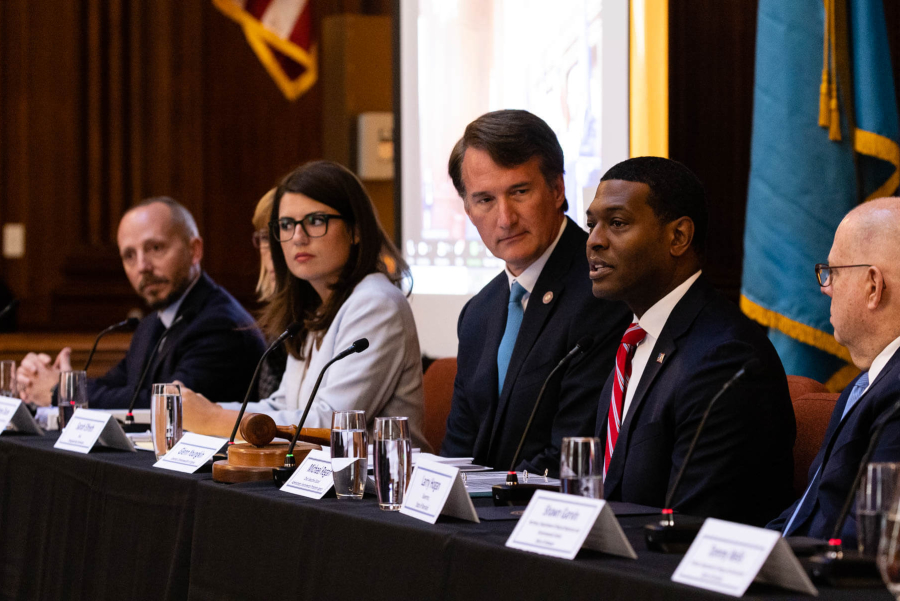Looking to the future, the Chesapeake Executive Council begins to set a plan to reach 2025
Annual meeting hears messages of inspiration amid recent mixed results of progress

At their annual meeting, the Chesapeake Executive Council discussed what has been on everyone’s mind lately—2025. Yes, there are still over two years to go before we flip our calendars, but for those involved in the Bay restoration movement, this date looms large ahead.
Back in June 2014, the Executive Council signed the Chesapeake Bay Watershed Agreement, consisting of 10 goals and 31 outcomes, with the vision of fostering an environmentally and economically sustainable watershed with clean water, abundant life, conserved lands and access to the water, a vibrant cultural heritage, and a diversity of engaged residents and stakeholders.
Many of the outcomes in the Watershed Agreement set 2025 as the target in which to meet their goals. One such outcome was the 2025 Watershed Implementation Plans (WIPs). The 2025 WIPs outcome measures the progress made by the seven watershed jurisdictions (Delaware, the District of Columbia, Maryland, New York, Pennsylvania, Virginia and West Virginia) in meeting their Chesapeake Bay Total Maximum Daily Load, or Bay TMDL, goals.
The Bay TMDL was established in 2010 and seeks to restore the Chesapeake by reducing the amount of pollution entering the Bay from each of the watershed jurisdictions. In particular, the Bay TMDL calls for 100% of pollution-reducing practices to be put into place by 2025 to ensure the Bay will meet standards for healthy water quality, as defined by the Environmental Protection Agency (EPA). The EPA recently released a review of the progress that the seven watershed jurisdictions are making toward this goal.
EPA Regional Administrator Adam Ortiz admitted that “most of the partnership is not on track for the 2025 targets, but we are encouraged by significant recent progress made in the states.” Examples of this type of progress came from both Delaware and Virginia in their remarks. Governor John Carney noted Delaware’s Cover Crop Cost Share and Soil Health initiatives that were specifically “developed for maintaining healthy local waterways and a healthy Chesapeake Bay.” In turn, Governor Glenn Youngkin spoke of the “record investment of almost $140 million in new cost-share funding for agricultural best management practices” recently passed in Virginia.
The Council agreed to set a path forward over the next year to outline the steps necessary to reach the Watershed Agreement targets, which potentially will include prioritizing which outcomes should be met by 2025. This critical plan will be unveiled at the 2023 Executive Council meeting, just in time for the Chesapeake Bay Program’s 40th anniversary.
Attendees of the public meeting also heard from retiring Chesapeake Bay Commission Executive Director Ann Swanson as she reflected on her 40 years of services to the Chesapeake Bay, leaving behind a message to the Council that the eyes of world are watching this partnership and rooting for its success.
The 2021-2022 Bay Barometer: An Annual Report on the State of the Program and the Health of the Bay was unveiled in the State of the Program address by EPA Chesapeake Bay Program Office Director Dr. Kandis Boyd. The newest Bay Barometer offers a snapshot of the Chesapeake Bay Program’s activities and accomplishments over the past year. In particular, it provides data updates for the following Watershed Agreement outcomes: 2025 Watershed Implementation Plans, Blue Crab Abundance, Forest Buffers, Oysters, Public Access Sites, Submerged Aquatic Vegetation (SAV), Sustainable Schools, Toxic Contaminants Policy & Prevention and Water Quality Standards and Attainment. For information on the most up-to-date progress for all 31 outcomes of the Watershed Agreement, please visit ChesapeakeProgress.
EPA Administrator Michael Regan was unanimously elected to a second-term as Executive Council Chair. In this role, he will oversee the 39-year-old Council, which is responsible for guiding the policy agenda, and setting conservation and restoration goals for the Chesapeake Bay Program.
“The Chesapeake Bay is a vital economic engine and an irreplaceable environmental asset,” said Administrator Regan. “EPA is honored to join our partners as we work to deliver on our restoration goals, build resilience to climate change and ensure that the benefits of our efforts are shared by all. With the support of historic levels of funding from the Bipartisan Infrastructure Law, we will work to advance our collective commitments to a clean Bay and watershed.”

Comments
Interesting that MD is not mentioned in the article, thats because the Hogan Administration has not made improving the bay health a priority.
Thank you!
Your comment has been received. Before it can be published, the comment will be reviewed by our team to ensure it adheres with our rules of engagement.
Back to recent stories